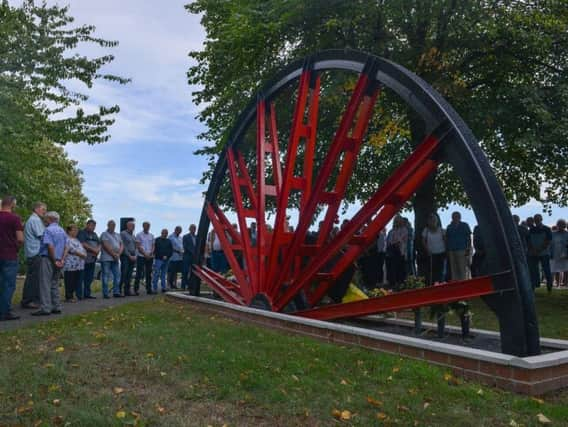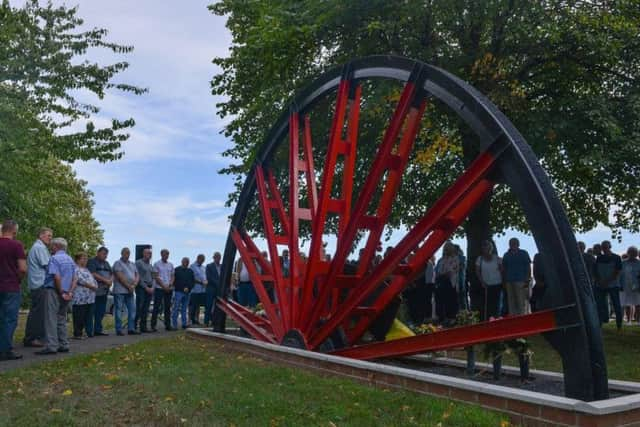Bilsthorpe Colliery disaster remembered 25 years on


More than 150 people gathered on Saturday to remember the three men who were killed in the Bilsthorpe Colliery disaster.
Twenty-six-year old Bill McCulloch, of Rainworth, Peter Alcock, 50, and under-manager, 31-year-old David Shelton, from Blyth were remembered at a short ceremony outside the former colliery.
Advertisement
Hide AdAdvertisement
Hide AdThe event was officiated by lay preacher Heather Brown and family members, friends and former colleagues attended a reunion held afterwards at the miners’ welfare club.


Your Chad looks back at the terrible events of August 18, 1993.
Miners were clocking on for what they thought would just be a normal shift at Bilsthorpe Colliery.
Tragedy struck just before 11am as development workers were digging a tunnel through to a new seam of coal.
Advertisement
Hide AdAdvertisement
Hide AdThey were working nearly 2,000ft underground and were around four miles from the bottom of the shaft when the roof fell in.
The three colleagues were killed when the roof of the tunnel they were working in collapsed.
Miraculously fellow pitmen Orest Kocij, Paul Smith and Russell Turner survived, despite being trapped by around 7,000 tonnes of collapsed rock 2,300 feet underground.
Former colliery electrician Brian Jackson is a volunteer at the Bilsthorpe Heritage Centre.
Advertisement
Hide AdAdvertisement
Hide AdHe told of the harrowing events which still bring him to tears more than two decades later.
“Although you would like to forget the day, you cannot because of the three guys who I knew very, very well,” he said.
“It was a nice day - breezy, sunny. We had our snap at 11 o’clock and we were going to be loading some cables to send underground.
“I was the fork lift driver. I went to diesel up.
“One of the rescue teams came up with their blues on.
“I thought he’s in a hurry, must be an exercise. I got back to the workshop and it was silent. I thought something was wrong.
Advertisement
Hide AdAdvertisement
Hide Ad“Then the shop foreman came out and said ‘there’s been an accident underground, we are not to load the cables and we are to wait for orders’ - and then anything they requested was ready to go underground.
“It wasn’t until later we started to get details of what was unfolding underground.”
Rescuers managed to make contact with the miners almost immediately via the underground telephone system.
Rescue teams from the Mines’ Rescue Service in Mansfield Woodhouse were immediately called and the flying squad from King’s Mill Hospital was put on standby.
Advertisement
Hide AdAdvertisement
Hide AdThey worked quickly to drill through the debris in an attempt to get an air supply through to the men.
Mr Jackson added: “There were five men missing - two they managed to communicate with who were at the front of the fall, they got them out by midnight time.
“Then it became obvious that there were three fatalities and that is when it started to really feel bad.
“I was sent home at 6.45pm that night having been at work 12-and-a-half hours - they said ‘we need you back in the morning’.
Advertisement
Hide AdAdvertisement
Hide Ad“It was holiday time and people were away on holiday, we were very short-staffed as the electricians were on the pit top.
“Half of them were away on holiday. One of the guys was in Turkey and he saw a newspaper that was two days old and realised he would have to make a decision whether to make his way home.”
He said the whole village seemed a different place when he arrived home that night.
“People were in shock, almost as if to say ‘not again’ because this is the third major accident at Bilsthorpe,” he told your Chad.
Advertisement
Hide AdAdvertisement
Hide Ad“The shaft failure on March 1 1927 and the July 1934 explosion.
“The pit has had 72 fatalities in its 72 years, it shows what kind of industry it was.
“Men have been crushed, buried and trapped. That was the human price of coal.
“The atmosphere was very sombre. People had memories who had lost ones in the past. People get older but they still remember when relatives and friends have been lost. All too many.
Advertisement
Hide AdAdvertisement
Hide Ad“That August 18 was a day ou would like to forget but I cannot because three of those guys I knew very very well.
“It still gets to you that you have lost your colleagues. Absolutely awful.
“We want to keep their memories alive.”
As details of the terrible accident emerged, so did stories of incredible bravery, endurance and teamwork.
In 1995, under-manager David Shelton posthumously received the George Medal for his efforts to save his colleagues.
Advertisement
Hide AdAdvertisement
Hide AdAs the roof started to cave in he tried to alert his workmates to the danger, sacrificing his own opportunity to escape.
Survivors Ray Thompson and Richard Derbyshire were also honoured for their efforts in the inspirational rescue operation.
Stuart Clifford, who helped several of his colleagues run to safety after seeing the roof begin to collapse, and Southwell policeman Sgt Geoff Tindall, who remained on duty at the accident site for 48 hours, were both praised for their bravery and commitment.
Brian Langdon, HM Deputy Chief Inspector of Mines, said in his report: “The task was extremely difficult and during this time several men showed great fortitude in the best traditions of mine rescue and are worthy of the highest commendation.”
Advertisement
Hide AdAdvertisement
Hide AdThe disaster sparked a long-running row and inquiry into the use of controversial roof bolting and skin-to-skin mining – a procedure where new “roads” are opened alongside old ones.
As people fought to find an explanation for the cause of the tragedy, local politicians demanded a public inquiry after an initial HSE report was dubbed a “whitewash”.
Ultimately, Sir Bernard Crossland’s inquiry decided roof bolting was not the cause of the accident and that no kind of supports could have stopped the collapse.
He blamed a unique series of circumstances connected to skin-to-skin mining.
Advertisement
Hide AdAdvertisement
Hide AdBilsthorpe Colliery was sunk in 1925 and was eventually closed in 1997.
Bilsthorpe Heritage Museum on Cross Street is home to a huge collection of mining memorabilia and photographs documenting the colliery and mining life.